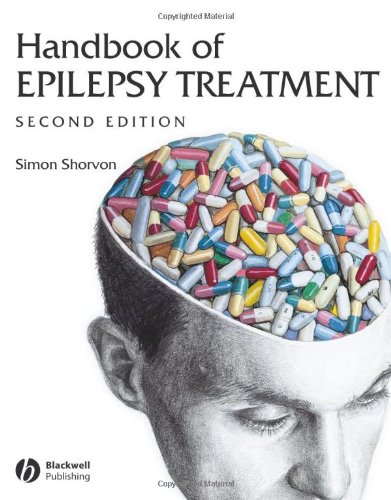

Most ebook files are in PDF format, so you can easily read them using various software such as Foxit Reader or directly on the Google Chrome browser.
Some ebook files are released by publishers in other formats such as .awz, .mobi, .epub, .fb2, etc. You may need to install specific software to read these formats on mobile/PC, such as Calibre.
Please read the tutorial at this link: https://ebookbell.com/faq
We offer FREE conversion to the popular formats you request; however, this may take some time. Therefore, right after payment, please email us, and we will try to provide the service as quickly as possible.
For some exceptional file formats or broken links (if any), please refrain from opening any disputes. Instead, email us first, and we will try to assist within a maximum of 6 hours.
EbookBell Team

4.0
26 reviews
ISBN 10: 1405131349
ISBN 13: 9781405131346
Author: Simon Shorvon
The Handbook of Epilepsy Treatment: forms, causes and therapy in children and adults provides a comprehensive coverage of medical and surgical therapy. It includes sections on: all current antiepileptic drugs; drug choice; pharmacokinetics; various surgical approaches; complementary and alternative therapies; emergency treatment of seizures and of status epilepticus; the treatment of psychiatric disorders associated with epilepsy; genetic counselling.
There are practical guides for the treatment of patients with newly diagnosed epilepsy, chronic epilepsy and epilepsy in remission, and sections on therapy in different epilepsy types and syndromes and in different patient groups such as children, women and elderly. The book also has also an opening chapter on the clinical forms and causes of epilepsy, and throughout the text new information is incorporated, particularly from the rapidly advancing fields of clinical genetics and clinical pharmacology.
The Handbook of Epilepsy Treatment: forms, causes and therapy in children and adults aids the doctor in the day-to-day management of the patient with epilepsy. It provides enough detail to be useful as a reference and yet gives information in an easy-to-use format for busy clinical practice. This concise and readable book is an invaluable guide for all doctors, regardless of specialty, seeing patients. A new pharmacopoeia is appended for quick reference and there are approximately 200 tables/figures/summary tables to assist clarity.
1: The clinical forms and causes of epilepsy
Epilepsy
ILAE classification of seizure type
ILAE classification on the epilepsies and epilepsy syndromes
Classification of partial seizures by anatomical site of seizure onset
The age-related epilepsy syndromes
The causes of epilepsy
Epilepsy due to genetic or developmental causes
Epilepsy due to acquired causes
Seizure precipitants
The reflex epilepsies
Acute symptomatic seizures
2: The principles of drug treatment
Why treat epilepsy?
Pharmacokinetic principles of antiepileptic drug treatment
Choice of drugs for different seizure types
Treatment of specific epilepsy syndromes
Principles of treatment of newly diagnosed patients
Principles of treatment of patients with established active epilepsy
Treatment of patients with epilepsy in remission
Treatment of epilepsy in children
The treatment of epilepsy in the elderly
The treatment of epilepsy in women
The treatment of psychiatric disorders in epilepsy
Complementary and alternative therapy in epilepsy
Genetic counselling in epilepsy
3: The antiepileptic drugs
Carbamazepine
Clobazam
Clonazepam
Ethosuximide
Gabapentin
Lamotrigine
Levetiracetam
Oxcarbazepine
Phenobarbital
Phenytoin
Pregabalin
Primidone
Tiagabine
Topiramate
Valproate
Vigabatrin
Zonisamide
Other drugs used in the treatment of epilepsy:
Acetazolamide
BenzodiazepinesDiazepam
Clorazepate
Nitrazepam
Corticosteroids and adrenocorticotropic hormone (ACTH)
Felbamate
Mesuximide
Piracetam
Rufinamide
4: The emergency treatment of epilepsy
The immediate management of a seizure
Status epilepticus
Antiepileptic drugs used in status epilepticus
5: The surgical treatment of epilepsy
Introduction
Pre-surgical assessment — general points
Surgery in epilepsy arising in the mesial temporal lobe
Surgery in epilepsy arising in extra-temporal regions and in the temporal neocortex
Surgery where no lesion is apparent on neuroimaging
Hemispherectomy, hemispherotomy and other large resections
Corpus callosectomy (corpus callosum section, corpus callosotomy)
Multiple subpial transection
Vagus nerve stimulation
Other functional surgical procedures
The organization of epilepsy surgery care: the epilepsy surgery centre
handbook of epilepsy treatment
sign epilepsy guidelines
epilepsy treatment guidelines 2021
handbook of eeg interpretation pdf
4 types of epilepsy
epilepsy 101 book
epilepsy textbook pdf
understanding epilepsy pdf
Tags: Simon Shorvon, Epilepsy, Treatment